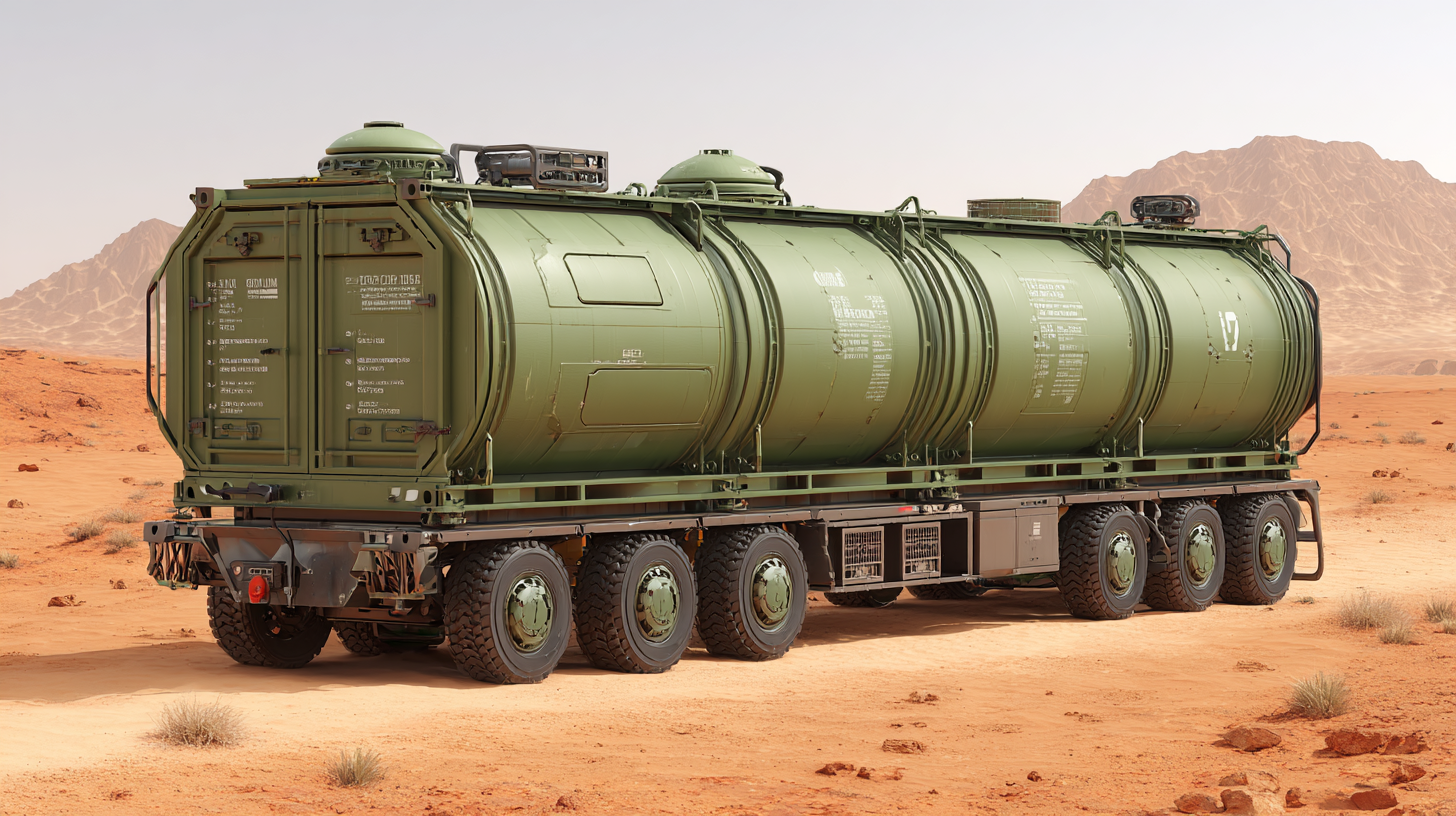- Home
- >
- Knowledge Center
- >
- Blogs
Blogs
Sharing knowledge is key to an innovative and healthy industry! This knowledge center is therefore a central place on our website to share information. Read all about our industry in the blogs below!
The Future of Eco Friendly Tank Shipping Container Solutions
As the global shipping industry faces increasing pressure to adopt sustainable practices, the future of eco-friendly solutions in tank shipping containers becomes a critical focus. The intricate balance of efficiency, safety, and environmental responsibility is steering innovations that redefine how liquid cargo is transported. This blog will provide an insightful checklist on the latest advancements and best practices for employing tank shipping containers that prioritize ecological impact. By exploring materials, technology, and operational strategies, we aim to equip industry stakeholders with the necessary tools to make informed decisions that not only enhance their business sustainability but also contribute to a greener future. Join us as we delve into the transformative potential of tank shipping containers in creating a more environmentally conscious shipping ecosystem.

The Role of Eco-Friendly Tank Shipping Containers in Sustainable Trade Practices
The growing concern for environmental sustainability is transforming global trade practices, particularly in the shipping sector. Eco-friendly tank shipping containers have emerged as a crucial solution in reducing the carbon footprint associated with traditional shipping methods. According to a report by the International Maritime Organization (IMO), the maritime sector is responsible for approximately 2-3% of global greenhouse gas emissions, highlighting the urgent need for more sustainable practices. Transitioning to eco-friendly containers can significantly mitigate these emissions, using materials and designs that emphasize recyclability and energy efficiency.

Furthermore, a study by the Global Logistics Emissions Council indicates that utilizing eco-friendly tank containers can lead to a 30% reduction in fuel consumption compared to conventional options. These containers are often made from sustainable materials and are designed to optimize space and reduce waste during transportation. As businesses increasingly prioritize sustainability, the adoption of these eco-friendly solutions in trade practices not only aligns with regulatory requirements but also meets consumer demand for greener options. This shift signals a positive trend towards a more sustainable future in global trade, paving the way for innovative practices that benefit both the environment and the economy.
Impact of Regulatory Compliance on Eco-Friendly Shipping Solutions
The increasing awareness of environmental issues has pushed the shipping industry towards more sustainable practices. Regulatory compliance plays a pivotal role in shaping eco-friendly tank shipping container solutions. Governments across the globe are implementing stricter environmental regulations aimed at reducing carbon emissions and promoting the use of renewable resources. This regulatory landscape compels shipping companies to innovate and adopt greener technologies, ensuring that their operations align with sustainability goals.

As companies transition to eco-friendly shipping solutions, they also encounter opportunities for growth and differentiation in a competitive market. Compliance not only assists in meeting environmental legislation but can also lead to cost savings through more efficient practices and technology. For instance, investing in advanced tank containers made from sustainable materials can reduce the carbon footprint while enhancing the reputation of the shipping company. Ultimately, the interplay between regulatory compliance and eco-friendly initiatives will shape the future of maritime shipping, driving it towards a more sustainable horizon.
Analyzing the Market Demand for Green Tank Shipping Containers in 2023
The demand for eco-friendly tank shipping container solutions is surging as global trade dynamics evolve in 2023. With the Hydrogen Tanks Market projected to reach USD 3.78 billion by 2030, businesses must adapt to capitalize on this rapid growth. Reports indicate a significant shift towards green hydrogen technologies, driving the need for specialized storage solutions. These advancements are not only pivotal in meeting operational requirements but also in aligning with sustainability goals.
In tandem, the ISO Tank Container Market is expected to reach USD 355.7 million, reflecting the rising importance of environmentally conscious logistics. As international trade expands, the efficiency and eco-friendliness of ISO containers are becoming integral to supply chain management. These containers are designed to minimize carbon footprints while enhancing logistical capabilities, making them a preferred choice for companies committed to reducing their environmental impact. Embracing these innovations will be crucial for businesses looking to thrive in an increasingly competitive and eco-conscious marketplace.
Innovative Materials and Technologies Revolutionizing Eco-Friendly Shipping
The shipping industry is undergoing a significant transformation, as innovative materials and technologies pave the way for eco-friendly tank shipping container solutions. Recent reports from the International Maritime Organization indicate that shipping accounts for approximately 2.5% of global greenhouse gas emissions. In response, industry leaders are exploring alternatives such as bio-based plastics and advanced composites, which can reduce the carbon footprint associated with container production. For instance, researchers have developed a new type of container made from bio-reinforced polymers, which not only weighs less but also has a lower environmental impact during its lifecycle.
Furthermore, the integration of smart technologies is enhancing the efficiency of eco-friendly shipping containers. Internet of Things (IoT) sensors can monitor and optimize logistics, minimizing waste and energy consumption. A 2022 report by the Global Marine Technology Trends predicts that adopting these smart technologies could reduce operational costs by up to 30%, while improving overall sustainability. By utilizing innovative materials combined with cutting-edge technology, the shipping sector is positioning itself to not only comply with regulatory demands but also to lead the way toward a greener future.
The Future of Eco Friendly Tank Shipping Container Solutions
| Material Type | Recyclability | Weight (kg) | Cost (USD) | CO2 Emissions (kg) |
|---|---|---|---|---|
| Aluminum | Yes | 150 | 3000 | 15 |
| Recycled Steel | Yes | 200 | 2500 | 20 |
| Biodegradable Composite | Yes | 180 | 3500 | 10 |
| Fiber Reinforced Polymer | No | 170 | 4000 | 12 |
| Bamboo | Yes | 150 | 2800 | 8 |
Best Practices for Achieving Export Certification in Eco-Conscious Shipping Operations
The landscape of eco-conscious shipping operations is evolving as more businesses strive to achieve export certification through sustainable practices. Companies are increasingly integrating eco-friendly strategies into their logistics frameworks, reflecting a growing commitment to environmentally responsible operations. Utilizing sustainable shipping Incoterms, businesses can promote green practices throughout the international trade process, which not only reduces carbon footprints but also enhances compliance with emerging regulations focused on sustainability.
To effectively achieve export certification, organizations must adopt best practices that emphasize eco-design and efficient resource management. This involves re-evaluating packaging choices, optimizing delivery routes, and leveraging technology to minimize environmental impact. Initiatives such as utilizing biodegradable materials and reducing waste throughout the supply chain are essential. Furthermore, engaging with stakeholders and adhering to institutional pressures can drive a culture of sustainability that benefits the entire shipping ecosystem. By aligning with these practices, companies not only position themselves as leaders in eco-friendly logistics but also appeal to a growing consumer base that prioritizes sustainability.
